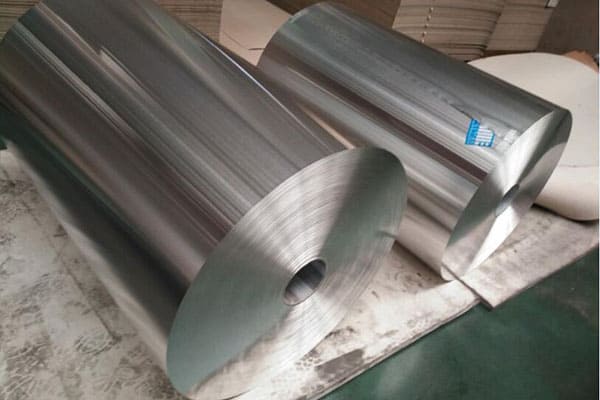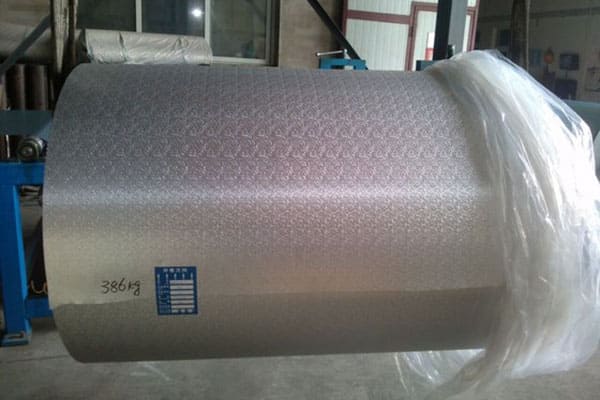Due to its excellent properties, aluminum foil is widely used in food, beverages, cigarettes, medicines, photographic plates, household daily necessities, etc., and is usually used as its packaging material; electrolytic capacitor material; insulation material for buildings, vehicles, ships, houses, etc.; it can also be used as decorative gold and silver wires, wallpapers, and decorative trademarks for various stationery prints and light industrial products. Among the above-mentioned uses, the most effective way to play the performance points of aluminum foil is as a packaging material. Aluminum foil is a soft metal film. It not only has the advantages of moisture-proof, airtight, light-shielding, abrasion-resistant, fragrance-preserving, non-toxic and tasteless, but also because of its elegant silver-white luster, it is easy to process beautiful patterns and patterns of various colors, so it is more likely to be favored by people’s aluminum foil tape.
Especially after aluminum foil is compounded with plastic and paper, the shielding property of aluminum foil is integrated with the strength of paper and the heat sealing property of plastic, which further improves the shielding performance of water vapor, air, ultraviolet rays and bacteria required as a packaging material, and greatly broadens the application market of aluminum foil. Since the packaged items are fully isolated from the light, moisture, and air outside, the packaging is well protected. Especially for the packaging of steamed food, the use of this composite aluminum foil material can ensure that the food will not deteriorate for at least one year. Moreover, it is very convenient to heat and open the package, which is very popular among consumers.

Classification and characteristics of aluminum foil
With the improvement of people’s living standards and the development of tourism, the demand for beverages such as beer, soda and canned food is increasing, which requires modern packaging and decoration to facilitate competition in the international market. In recent years, in order to meet market requirements, people have developed packaging materials such as plastic films and spray-coated foils with good shielding properties, but their comprehensive performance is not as good as that of over-coating and lamination processing. Therefore, it can be said that aluminum foil is a relatively perfect packaging material with multiple excellent properties, which fully demonstrates its broad application prospects in many fields.
In order to improve the rolling efficiency and the quality of aluminum foil products, modern aluminum foil rolling mills are developing in four directions: large coils, wide widths, high speeds and automation. The roller width of contemporary aluminum foil rolling mills has reached more than 2200mm, the rolling speed has reached more than 2000m/min, and the coil weight has reached more than 20t. The corresponding rolling mill automation level has also been greatly improved, and thickness control systems (AGC) are generally installed, and most are equipped with flatness gauges (AFC). The aluminum foil industry is facing a period of rapid development.
Aluminum foil can be divided into thick foil, single zero foil and double zero foil according to thickness.
Aluminum foil can be divided into roll aluminum foil and sheet aluminum foil according to its shape. Most of the aluminum foil deep processing raw materials are supplied in rolls, and only a few handicraft packaging occasions use sheet aluminum foil.
Aluminum foil can be divided into hard foil, semi-hard foil and soft foil according to its state.
Aluminum foil can be divided into one-sided smooth aluminum foil and two-sided smooth aluminum foil according to the surface state.
Aluminum foil can be divided into plain foil, embossed foil, composite foil, coated foil, colored foil and printed foil according to the processing technology.
Soft aluminum foil can also be further pressed into 40 foil for high-end decoration.

Embossed aluminum foil
Aluminum foil has a clean, hygienic and shiny appearance. It can be integrated with many other packaging materials. The printing effect of aluminum foil surface is better than other materials. In addition, aluminum foil has the following characteristics:
In the production of double foil, the rolling of aluminum foil is divided into three processes: rough rolling, medium rolling and finishing rolling. From the perspective of technology, it can be roughly divided according to the thickness of the rolling outlet. The general classification method is that the outlet thickness is greater than or equal to 0.05mm for rough rolling, the outlet thickness is between 0.013 and 0.05 for medium rolling, and the outlet thickness is less than 0.013mm for single finished products and double rolled finished products for finishing rolling. Rough rolling is similar to the rolling characteristics of aluminum strips. The thickness control mainly depends on the rolling force and post-tension. The rough rolling processing rate thickness is very small. Its rolling characteristics are completely different from the rolling of aluminum strips. It has the particularity of aluminum foil rolling. Its characteristics are mainly in the following aspects:
(1) Aluminum strip rolling. To make the aluminum strip thinner, it mainly depends on the rolling force. Therefore, the plate thickness automatic control method is a control method with constant roll gap as the main body of AGC. Even if the rolling force changes, the roll gap can be adjusted at any time to keep the roll gap at a certain value to obtain a plate with consistent thickness. When aluminum foil is rolled to the intermediate finishing rolling, due to the extremely thin thickness of the aluminum foil, it is easier to increase the rolling force during rolling to make the roller produce elastic deformation than the rolled material produce plastic deformation. The elastic flattening of the roller cannot be ignored. The elastic flattening of the roller determines that the rolling force in the rolling of aluminum foil can no longer play the same role as that of rolling plates. Aluminum foil rolling is generally a roll gapless rolling under constant pressure conditions. The adjustment of the thickness of the aluminum foil mainly depends on the adjustment of the tension and rolling speed.
(2) Overlap rolling. For extremely thin aluminum foil with a thickness of less than 0.012mm (the thickness is related to the diameter of the working roll), it is very difficult to use a single sheet rolling method due to the elastic flattening of the roller. Therefore, the double-combined rolling method is adopted, that is, adding lubricating oil between two sheets of aluminum foil and then rolling them together (also called overlap rolling). The overlapping rolling process can not only produce extremely thin aluminum foil that cannot be produced by single sheet rolling, but also reduce the number of strip breaks and improve labor productivity. This process can mass-produce single-sided smooth aluminum foil of 0.006mm to 0.03mm.
(3) Speed effect. During the rolling process of aluminum foil, the phenomenon that the thickness of the foil becomes thinner as the rolling speed increases is called the speed effect. The explanation of the speed effect mechanism still needs in-depth research. The reasons for the speed effect are generally believed to be the following three aspects:
Upgrade your roof with high-quality aluminum roofing sheets. Experience long-lasting protection and enhance your home's aesthetics with our stylish and durable roofing solution
Aircraft grade aluminum sheet is a type of aluminum alloy that is specifically designed for use in aerospace applications. These sheets are made from high-strength aluminum alloys that are lightweight yet strong enough to withstand the stresses and strains of flight.
1060 Aluminum Coil is composed of 99.6% aluminum, which is similar to the 1050 alloy of the same family, but the aluminum content differs by 0.1%.
Aluminium circle for cookwares typically refers to a circular-shaped piece or circle made from aluminum that is used in the manufacturing of various types of cookware, such as pots, pans, and cooking utensils.
Painted aluminum coil (Coated aluminum coil) is a popular material choice for construction, transportation, and signage due to its lightweight, durability, and versatility.
Huawei Aluminum is a large-scale 5052 aluminum foil raw material manufacturer, with 30 years of experience in aluminum foil production and sales.
No.52, Dongming Road, Zhengzhou, Henan, China
Henan Huawei Aluminum Co., Ltd, One Of The Biggest Aluminum Supplier In China Henan,We Are Established In 2001,And We Have rich experience in import and export and high quality aluminum products
Mon – Sat, 8AM – 5PM
Sunday: Closed
© Copyright © 2023 Henan Huawei Aluminium Co., Ltd
Latest Comments
Dear Sir, Please offer your best FOB Prices specs are as under ALUMINIUM STRIP (AL=99.50% MIN) SIZE:450 X32 X6 MM. DIN EN 570 EN-AW 1050 A, QUANTITY=3400KG
Hello, Would you be so kind to offer item as follows: Coil 0,6х1250 (1000)mm EN AW-3105 5tons
Hello, Can you offer me Aluminium plates? Actally I need: 110mm x 1700mm x 1700mm 5083 H111 - 21 pcs Next year planed is 177 pcs
Świetny artykuł. Byłem zachwycony, że wyszukałem ten artykuł. Wielu osobom wydaje się, że mają rzetelną wiedzę na ten temat, ale często tak nie jest. Stąd też moje miłe zaskoczenie. Jestem pod wrażeniem. Zdecydowanie będę rekomendował to miejsce i częściej wpadał, aby zobaczyć nowe rzeczy.
requirement of aluminium strip